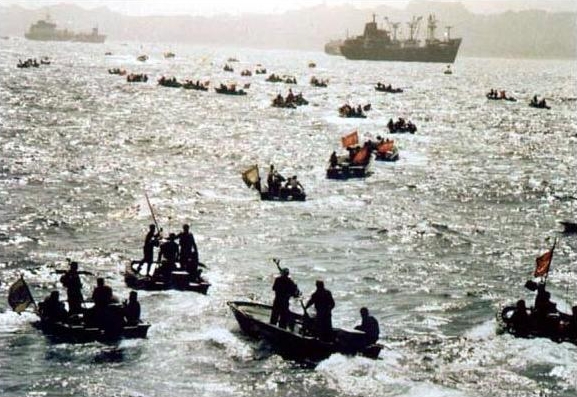
A number of states in the Persian/Arabian Gulf have navies. These include frigates and other significant warships. It also includes submarines in the case of Iran.
Saudi Arabia has 7 frigates, 4 corvettes, 9 patrol boats and 3 minesweepers (needed for the Gulf). This is not an insignificant force (See: Royal Saudi Navy).
The United Arab Emirates have 9 corvettes and 9 fast attack craft and other larger patrol vessels (See: United Arab Emirates Navy)
Little Bahrain (which is majority Shiite, even though the royal family is Sunni) has 1 frigate and 6 patrol craft of note (See: Royal Bahrain Naval Force).
Iraq has 2 corvettes and 6 patrol vessels of note (See: Iraqi Navy)
Oman has 5 corvettes and 12 patrol vessels (See: Royal Navy of Oman).
Kuwait has 10 Fast Patrol Boats (See: Kuwait Naval Force)
The outcast Qatar has 7 Fast attack craft (See: Qatari Emiri Navy)
These seven nations have an interest in either keeping the Persian/Arabian Gulf open or at least remaining neutral in such a conflict. Still, it appears they could muster together 8 frigates, up to 20 corvettes and up to 59 larger patrol craft. There are also a lot of smaller patrol craft which I have not listed.
And then there is Iran, one of only three nations in the world with a Shiite majority (the other two being Iraq and Bahrain). It has the largest navy in the area with around 18,000 personnel (2011 estimate). They have 3 large submarines (2325 tons), 4 smaller submarines (350 to 1200 tons), 27 really small submarines (90 to 120 tons) and 5 mini-subs (10 tons) They have 1 destroyer planned (7,500 tons), 6 frigates (1,500 to 2,000 tons), 3 corvettes (580 to 1,135 tons), 32 fast attack craft (205 to 447 tons), 97 coastal patrol boats (up to 148 tons), 83 smaller patrol boats (14 to 82 tons), 14 hovercraft, 3 submersible boats, 74 fast attack craft, 200+ miscellaneous small craft, 3 mine layers, 2 mine countermeasure ships, 26 landing craft, and 28 support ships. (See: Islamic Republic of Iran Navy). This is a lot of little ships and some significant big ships. The Islamic Revolutionary Guard Corps also maintains a large number of small craft (See: Navy of the Islamic Revolutionary Guard Corps). Some/most are counted above.
Anyhow, it is clear that the Iranian Navy is probably capable of shutting down traffic in the Gulf and this probably cannot be halted by the other Gulf navies. And then there are the air forces (subject of a post tomorrow).

The Iranians have purchased-received rocket assisted (deep bottom) mines from China. Specifically the EM-52 back in 1994 that can be reportedly lain as deep as 200M.
The Wikileaks releases on Iranian mines (search: iran em-52 mine) is not very comforting.
Thanks for the info. The maximum depth of the Persian/Arabian Gulf is 90 meters. The majority of the Gulf of Oman (which is about the size of Florida) is over 200 meters deep.
It doesn’t drop off a cliff. It funnels out to the Arabian Sea.
The extra depth allows the Iranians to bring the approaches around the Musandam Peninsula into play. Which is presumably why they acquired them along with their submarines.
The ability of any navy, not just the USN, to clear large areas of mines sitting on the ocean floor is very limited. It can be done, but takes a lot of time.
The likelihood of the Persian Gulf being shut down to commercial shipping for an extended time is very high.
It begs the question of the mines working, but navel mines are generally relatively simple compared to a lot of other modern navel equipment. But any untested system, is an untested system.